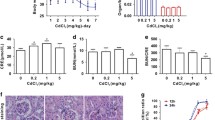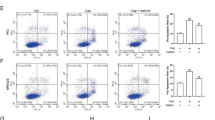Abstract
3-Chloro-1, 2-propanediol (3-MCPD) is a food-borne toxic substance well-known for more than 40 years that is mainly associated with nephrotoxicity. A better understanding of 3-MCPD nephrotoxicity is required to devise efficacious strategies to counteract its toxicity. In the present work, the role of endoplasmic reticulum (ER) stress along with its underlying regulatory mechanism in 3-MCPD-mediated renal cytotoxicity was investigated in vivo and in vitro. Our data indicated that 3-MCPD-stimulated ER stress response evidenced by sustained activation of PERK-ATF4-p-CHOP and IRE1 branches in Sprague Dawley (SD) rats and human embryonic kidney (HEK293) cells. Moreover, ER stress-associated specific apoptotic initiator, caspase 12, was over-expressed. Blocking ER stress with its antagonist, 4-phenylbutyric acid (4-PBA), improved the morphology and function of kidney effectively. 4-PBA also increased cell viability, relieved mitochondrial vacuolation, and inhibited cell apoptosis through regulating caspase-dependent intrinsic apoptosis pathways. Furthermore, the enhanced expressions of two mitochondrial fission proteins, DRP1/p-DRP1 and FIS1, and the relocation of DRP1 on mitochondria subjected to 3-MPCD were reversed by 4-PBA, while the expression of the fusion protein, MFN2, was restored. Moreover, cellular Ca2+ overload, the over-expression of CaMKK2, and the loss of mitochondria-associated membranes (MAM) were also relieved after 4-PBA co-treatment. Collectively, our data emphasized that ER stress plays critical role in 3-MCPD-mediated mitochondrial dysfunction and subsequent apoptosis as well as blockage of ER stress ameliorated kidney injury through improving mitochondrial fission/fusion and Ca2+ homeostasis. These findings provide a novel insight into the regulatory role of ER stress in 3-MCPD-associated nephropathy and a potential therapeutic strategy.
Graphical abstract

Graphical Headlights
1. 4-PBA inhibits ER stress mainly through regulating PERK-ATF4-CHOP and IRE1-XBP1s branches.
2. Inhibition of ER stress by 4-PBA mitigates ER associated and mitochondrial apoptosis
3. Inhibition of ER stress by 4-PBA helps maintaining calcium homeostasis and mitochondrial dynamic.








Similar content being viewed by others
Data availability
The data that support the findings of this study are available from the corresponding author upon reasonable request.
Abbreviations
- 3-MCPD:
-
3-Chloro-1, 2-propanediol
- SD:
-
Sprague-Dawley
- HEK293:
-
Human embryonic kidney
- LOVEL:
-
Lowest observed effect
- TDI:
-
Tolerable daily intake
- ER:
-
Endoplasmic reticulum
- UPR:
-
Unfolded protein response
- CKD:
-
Chronic kidney disease
- MAM:
-
Mitochondria-associated membranes
- 4-PBA:
-
4-Phenylbutyric acid
- H&E:
-
Hematoxylin and eosin
- DMSO:
-
Dimethyl sulfoxide
- MtMP:
-
Mitochondria membrane potential
- FBS:
-
Fetal bovine serum
- TEM:
-
Transmission electron microscope
References
Baer I, Calle DB, Taylor P. 3-MCPD in food other than soy sauce or hydrolysed vegetable protein (HVP). Anal Bioanal Chem. 2010;396(1):443–56. https://doi.org/10.1007/s00216-009-3177-y.
Bernardi P, Raslla A. Calcium and cell death: the mitochondrial connection. Calcium Sig Dis. 2007;18(1):481–506. https://doi.org/10.1007/978-1-4020-6191-2_18.
Bonnemaison ML, Marks-Nelson ES, Boesen EI. Sodium 4-phenylbutyrate treatment protects against renal injury in NZBWF1 mice. Clin Sci (Lond). 2019;133(2):167–80. https://doi.org/10.1042/CS20180562.
Chen F, Jin J, Hu J, Wang Y, Ma Z, Zhang J. Endoplasmic reticulum stress cooperates in silica nanoparticles-induced macrophage apoptosis via activation of CHOP-mediated apoptotic signaling pathway. Int J Mol Sci. 2019;20(23):5846–63. https://doi.org/10.3390/ijms20235846.
Cho WS, Han BS, Lee H, Kim C, Nam KT, Park K, et al. Subchronic toxicity study of 3-monochloropropane-1,2-diol administered by drinking water to B6C3F1 mice. Food Chem Toxicol. 2008;46(5):1666–73. https://doi.org/10.1016/j.fct.2007.12.030.
Cybulsky AV. Endoplasmic reticulum stress in proteinuric kidney disease. Kidney Int. 2010;77(3):187–93. https://doi.org/10.1038/ki.2009.389.
Dolezal M, Chaloupska M, Divinova V, Svejkovska B, Velisek J. Occurrence of 3-chloropropane-1,2-diol and its esters in coffee. Eur Food Res Technol. 2005;221(3-4):221–5. https://doi.org/10.1007/s00217-004-1118-8.
Gadicherla AK, Wang N, Bulic M, Agullo-Pascual E, Lissoni A, De Smet M, et al. Mitochondrial Cx43 hemichannels contribute to mitochondrial calcium entry and cell death in the heart. Basic Res Cardiol. 2017;112(3):27–48. https://doi.org/10.1007/s00395-017-0618-1.
Ganta KK, Chaubey B. Endoplasmic reticulum stress leads to mitochondria-mediated apoptosis in cells treated with anti-HIV protease inhibitor ritonavir. Cell Biol Toxicol. 2019;35(3):189–204. https://doi.org/10.1007/s10565-018-09451-7.
Giorgi C, Stefani DD, Bononi A, Rizzuto R, Pinton P. Structural and functional link between the mitochondrial network and the endoplasmic reticulum. Int J Biochem Cell Biol. 2009;41(10):1817–27. https://doi.org/10.1016/j.biocel.2009.04.010.
Hamlety CG, Jayaratney SM, Matthews W. 3-Monochloropropane-1,2-diol (3-MCPD) in food ingredients from UK food producers and ingredient suppliers. Food Addit Contam. 2002;19(1):15–21. https://doi.org/10.1080/0265203011007234.
Hoppins S, Nunnari J. Mitochondrial dynamics and apoptosis-the ER connection. Science. 2012;337(6098):1052–4. https://doi.org/10.1126/science.1224709.
Huang G, Gao B, Xue J, Cheng Z, Sun X, Zhang Y, et al. Toxicokinetics and Metabolism of 3-Monochloropropane 1,2-Diol Dipalmitate in Sprague Dawley Rats. J Agric Food Chem. 2018;66(44):11672–80. https://doi.org/10.1021/acs.jafc.8b05422.
Hwang M, Yoon E, Kim J, Jang DD, Yoo TM. Toxicity value for 3-monochloropropane-1,2-diol using a benchmark dose methodology. Regul Toxicol Pharmacol. 2009;53(2):102–6. https://doi.org/10.1016/j.yrtph.2008.12.005.
James DI, Martinou JC. Mitochondrial dynamics and apoptosis: a painful separation. Dev Cell. 2008;15(3):341–3. https://doi.org/10.1016/j.devcel.2008.08.011.
Jedrkiewicz R, Kupska M, Glowacz A, Gromadzka J, Namiesnik J. 3-MCPD: A worldwide problem of food chemistry. Crit Rev Food Sci Nutr. 2016;56(14):2268–77. https://doi.org/10.1080/10408398.2013.829414.
Ji J, Zhu P, Sun C, Sun JD, Lu A, Zhang YZ, et al. Pathway of 3-MCPD-induced apoptosis in human embryonic kidney cells. J Toxicol Sci. 2017;42(1):43–52. https://doi.org/10.2131/jts.42.43.
Kam MK, Lee DG, Kim B, Lee HS, Lee SR, Bae YC, et al. Peroxiredoxin 4 ameliorates amyloid beta oligomer-mediated apoptosis by inhibiting ER-stress in HT-22 hippocampal neuron cells. Cell Biol Toxicol. 2019;35(6):573–88. https://doi.org/10.1007/s10565-019-09477-5.
Karagas NE, Venkatachalam K. Roles for the the endoplasmic reticulum in regulation of neuronal calcium homeostasis. Cells. 2019;8(10):1232–63. https://doi.org/10.3390/cells8101232.
Kaze N, Watanabe Y, Sato H, Murota K, Kotaniguchi M, Yamamoto H, et al. Estimation of the intestinal absorption and metabolism behaviors of 2- and 3-monochloropropanediol esters. Lipids. 2016;51(8):913–22. https://doi.org/10.1007/s11745-016-4143-z.
Krebs J, Agellon LB, Michalak M. Ca2+ homeostasis and endoplasmic reticulum (ER) stress: An integrated view of calcium signaling. Biochem Biophys Res Commun. 2015;460(1):114–21. https://doi.org/10.1016/j.bbrc.2015.02.004.
Lee ES, Kim HM, Kang JS, Lee EY, Yadav D, Kwon MH, et al. Oleanolic acid and N-acetylcysteine ameliorate diabetic nephropathy through reduction of oxidative stress and endoplasmic reticulum stress in a type 2 diabetic rat model. Nephrol Dial Transplant. 2016;31(3):391–400. https://doi.org/10.1093/ndt/gfv377.
Li Y, Liu S, Wang C, Li K, Shan YJ, Wang XJ, et al. Novel biomarkers of 3-chloro-1,2-propanediol exposure by ultra performance liquid chromatography/mass spectrometry based metabonomic analysis of rat urine. Chem Res in toxicol. 2010;23(1):1012–7. https://doi.org/10.1021/tx900400p.
Li Y, Jiang W, Niu Q, Sun Y, Meng C, Tan L, et al. eIF2alpha-CHOP-BCl-2/JNK and IRE1alpha-XBP1/JNK signaling promote apoptosis and inflammation and support the proliferation of Newcastle disease virus. Cell Death Dis. 2019;10(12):891–906. https://doi.org/10.1038/s41419-019-2128-6.
Liang S, Liu H, Liu S, Wei M, Gao F, Xue J, et al. Homocysteine induces human mesangial cell apoptosis via the involvement of autophagy and endoplasmic reticulum stress. RSC Advances. 2019;9(54):31720–7. https://doi.org/10.1039/c9ra04248b.
Liu G, Sun Y, Li Z, Song T, Wang H, Zhang Y, et al. Apoptosis induced by endoplasmic reticulum stress involved in diabetic kidney disease. Biochem Biophys Res Commun. 2008;370(4):651–6. https://doi.org/10.1016/j.bbrc.2008.04.031.
Liu HG, Wang TTY, Sun X, Yu L. 3-MCPD 1-palmitate induced tubular cell apoptosis in vivo via JNK/p53 pathways. Toxicol Sci. 2016;151(1):181–92. https://doi.org/10.1093/toxsci/kfw033.
Luo ZF, Feng B, Mu J, Qi W, Zeng W, Guo YH, et al. Effects of 4-phenylbutyric acid on the process and development of diabetic nephropathy induced in rats by streptozotocin: regulation of endoplasmic reticulum stress-oxidative activation. Toxicol Appl Pharmacol. 2010;246(1-2):49–57. https://doi.org/10.1016/j.taap.2010.04.005.
MacMahon S, Beekman J. 3-Chloro-1,2-propanediol (3-MCPD), 2-chloro-1,3-propanediol (2-MCPD) and glycidyl esters in infant formula: a review. Curr Opin Food Sci. 2019;30:67–72. https://doi.org/10.1016/j.cofs.2019.05.005.
Maekawa HIR. Stress signal network between hypoxia and ER Stress in chronic kidney disease. Front Physiol. 2017;8:74–9. https://doi.org/10.3389/fphys.2017.00074.
Mahmoud YI, Abo-Zied FS, Salem ST. Effects of subacute 3-monochloropropane-1,2-diol treatment on the kidney of male albino rats. Biotech Histochem. 2019;94(3):199–203. https://doi.org/10.1080/10520295.2018.1543894.
Oyadomari S, Mori M. Roles of CHOP/GADD153 in endoplasmic reticulum stress. Cell Death Differ. 2004;11(4):381–9. https://doi.org/10.1038/sj.cdd.4401373.
Paillusson S, Stoica R, Gomez-Suaga P, Lau DHW, Mueller S, Miller T, et al. There’s something wrong with my MAM; the ER-mitochondria axis and neurodegenerative diseases. Trends Neurosci. 2016;39(3):146–57. https://doi.org/10.1016/j.tins.2016.01.008.
Patergnani S, Suski JM, Agnoletto C, Bononi A, Bonora M, De Marchi E, et al. Calcium signaling around mitochondria associated membranes (MAMs). Cell Commun Signal. 2011;9(1):19–29. https://doi.org/10.1186/1478-811X-9-19.
Peng XL, Gan J, Wang Q, Shi ZQ, Xia XD. 3-Monochloro-1,2-propanediol (3-MCPD) induces apoptosis via mitochondrial oxidative phosphorylation system impairment and the caspase cascade pathway. Toxicology. 2016;372(7):1–11. https://doi.org/10.1016/j.tox.2016.09.017.
Peter W, Ron D. The unfolded protein response: from stress pathway to homeostatic regulation. Science. 2011;334(25):1081–6. https://doi.org/10.1126/science.1209038.
Rizzuto R, Duchen MR, Pozzan T. Flirting in little space: the ER/mitochondria Ca2+ liaison. Sci STKE. 2004;(215):re1. https://doi.org/10.1126/stke.2152004re1.
Schroder M, Kaufman RJ. The mammalian unfolded protein response. Annu Rev Biochem. 2005;74:739–89. https://doi.org/10.1146/annurev.biochem.73.011303.074134.
Shu S, Zhu J, Liu Z, Tang C, Cai J, Dong Z. Endoplasmic reticulum stress is activated in post-ischemic kidneys to promote chronic kidney disease. EBioMedicine. 2018;37(1):269–80. https://doi.org/10.1016/j.ebiom.2018.10.006.
Silva-Palacios A, Zazueta C, Pedraza-Chaverri J. ER membranes associated with mitochondria: possible therapeutic targets in heart-associated diseases. Pharmacol Res. 2020;156(1):104758. https://doi.org/10.1016/j.phrs.2020.104758.
Suen DF, Norris KL, Youle RJ. Mitochondrial dynamics and apoptosis. Genes Dev. 2008;22(12):1577–90. https://doi.org/10.1101/gad.1658508.
Szegezdi E, Logue SE, Gorman AM, Samali A. Mediators of endoplasmic reticulum stress-induced apoptosis. EMBO Rep. 2006;7(9):880–5. https://doi.org/10.1038/sj.embor.7400779.
Tabas I, Ron D. Integrating the mechanisms of apoptosis induced by endoplasmic reticulum stress. Nat Cell Biol. 2011;13(3):184–90. https://doi.org/10.1038/ncb0311-184.
Vliet AR, Verfaillie T, Agostinis P. New functions of mitochondria associated membranes in cellular signaling. Biochim Biophys Acta. 2014;1843(10):2253–62. https://doi.org/10.1016/j.bbamcr.2014.03.009.
Wang H, Zhao X, Ni C, Dai Y, Guo Y. Zearalenone regulates endometrial stromal cell apoptosis and migration via the promotion of mitochondrial fission by activation of the JNK/Drp1 pathway. Mol Med Rep. 2018;17(6):7797–806. https://doi.org/10.3892/mmr.2018.8823.
Wei X, Wei X, Lu Z, Li L, Hu Y, Sun F, et al. Activation of TRPV1 channel antagonizes diabetic nephropathy through inhibiting endoplasmic reticulum-mitochondria contact in podocytes. Metabolism. 2020;105(1):154182. https://doi.org/10.1016/j.metabol.2020.154182.
Yum V, Carlisle RE, Lu C, Brimble E, Chahal J, Upagupta C, et al. Endoplasmic reticulum stress inhibition limits the progression of chronic kidney disease in the Dahl salt-sensitive rat. Am J Physiol Renal Physiol. 2017;312(1):F230–F44. https://doi.org/10.1152/ajprenal.00119.2016.
Zhong Y, Jin C, Wang X, Li X, Han J, Xue W, et al. Protective effects of apigenin against 3-MCPD-induced renal injury in rat. Chem Biol Interact. 2018;296:9–17. https://doi.org/10.1016/j.cbi.2018.08.005.
Code availability
Not applicable
Funding
This work was supported by grants from National Natural Science Foundation of China (NSFC, 31571928), the Science and Technology Plan Project of Shaanxi Province (2020NY-106), and Student’s Platform for Innovation and Entrepreneurship Training Program (1201710712149, 1201710712127).
Author information
Authors and Affiliations
Contributions
Xiaoli Peng, Yujie Zhong, and Xiaodong Xia contributed to the conception and design of the experiment. Material preparation, data collection, and analysis were performed by Yujie Zhong, Chengni Jin, and Jiahui Han. The first draft of the manuscript was written by Yujie Zhong. Qi Liu, Dianjun Sun, and Jiachang Zhu commented on previous versions of the manuscript. All authors have read and approved the final manuscript.
Corresponding author
Ethics declarations
Consent to participate
Not applicable.
Ethics approval
All animal procedures were performed in accordance with the Guide for the Care and Use of Laboratory Animals: Eighth Edition (ISBN-10: 0-309-15396-4) and approved by the Animal Ethics Committee of Northwest A&F University, and Chengdu Dossy Experimental Animals Co., Ltd (N19100398).
Consent for publication
Not applicable.
Conflict of interest
The authors declare that they have no conflict of interest.
Additional information
Publisher’s note
Springer Nature remains neutral with regard to jurisdictional claims in published maps and institutional affiliations.
Supplementary Information
ESM 1
(DOCX 883 kb)
Rights and permissions
About this article
Cite this article
Zhong, Y., Jin, C., Han, J. et al. Inhibition of ER stress attenuates kidney injury and apoptosis induced by 3-MCPD via regulating mitochondrial fission/fusion and Ca2+ homeostasis. Cell Biol Toxicol 37, 795–809 (2021). https://doi.org/10.1007/s10565-021-09589-x
Received:
Accepted:
Published:
Issue Date:
DOI: https://doi.org/10.1007/s10565-021-09589-x




